Page 312 of 531
The Infrared Three-Zone ATC System automatically
maintains the interior comfort level desired by the driver
and all passengers. This is accomplished by an infrared
sensor, located in the forward overhead console. Based
on the sensor input, the system automatically adjusts the
air temperature, the airflow volume, and amount of
outside air recirculation. This maintains a comfortable
temperature even under changing conditions.
Front Upper ATC Panel
1 - Left On/Off 9 - Right On/Off
2 - Blower 10 - AUTO Temp
3 - Left Front Temp 11 - MODE
4 - Rear Blower/Temp 12 - Front DEFROST
5 - SYNC Indicator 13 - RECIRCULATE
6 - A/C Indicator 14 - Blower
7 - Right Front Temp 15 - SYNC
8 - MODE 310 UNDERSTANDING YOUR INSTRUMENT PANEL
Page 315 of 531
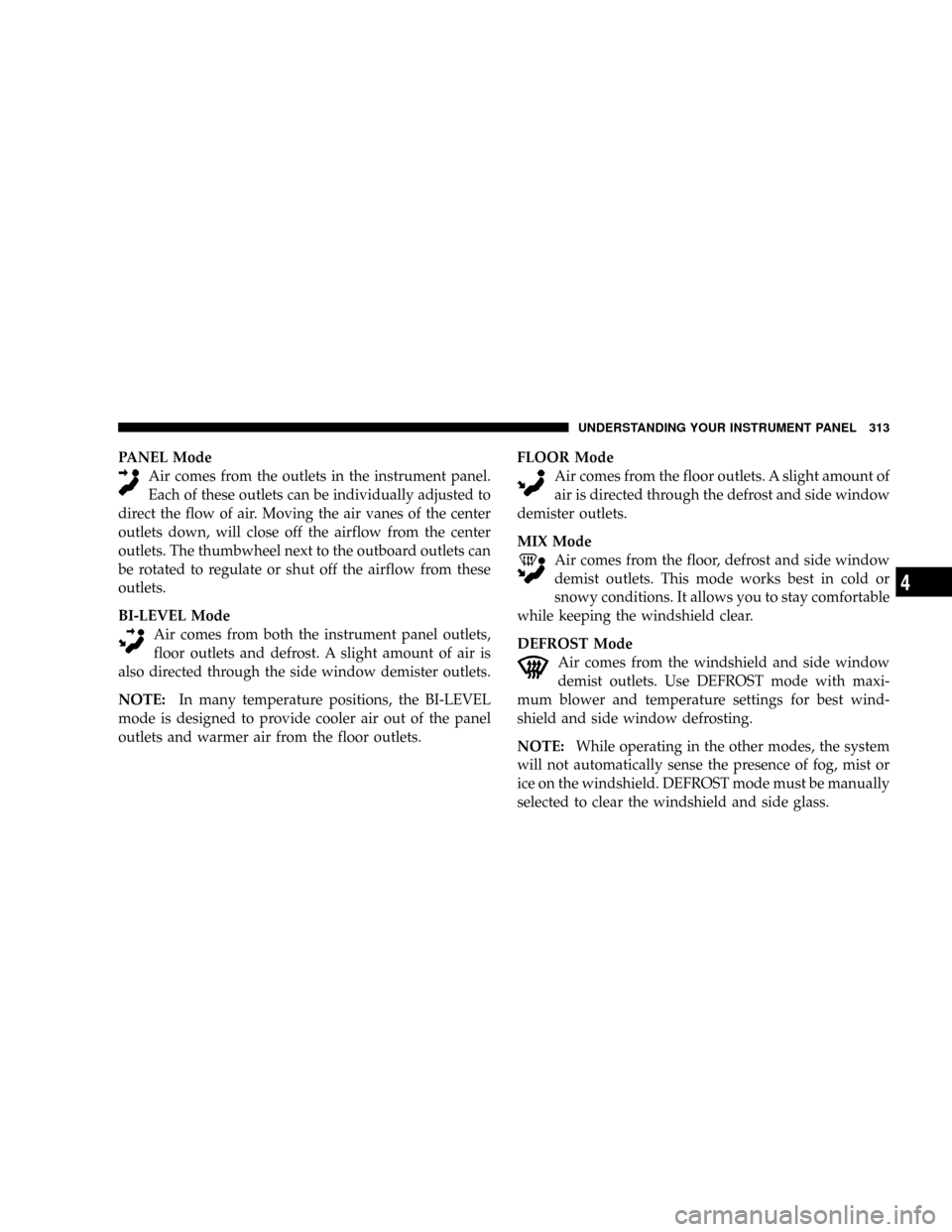
PANEL Mode
Air comes from the outlets in the instrument panel.
Each of these outlets can be individually adjusted to
direct the flow of air. Moving the air vanes of the center
outlets down, will close off the airflow from the center
outlets. The thumbwheel next to the outboard outlets can
be rotated to regulate or shut off the airflow from these
outlets.
BI-LEVEL Mode
Air comes from both the instrument panel outlets,
floor outlets and defrost. A slight amount of air is
also directed through the side window demister outlets.
NOTE:In many temperature positions, the BI-LEVEL
mode is designed to provide cooler air out of the panel
outlets and warmer air from the floor outlets.FLOOR Mode
Air comes from the floor outlets. A slight amount of
air is directed through the defrost and side window
demister outlets.
MIX Mode
Air comes from the floor, defrost and side window
demist outlets. This mode works best in cold or
snowy conditions. It allows you to stay comfortable
while keeping the windshield clear.
DEFROST Mode
Air comes from the windshield and side window
demist outlets. Use DEFROST mode with maxi-
mum blower and temperature settings for best wind-
shield and side window defrosting.
NOTE:While operating in the other modes, the system
will not automatically sense the presence of fog, mist or
ice on the windshield. DEFROST mode must be manually
selected to clear the windshield and side glass.
UNDERSTANDING YOUR INSTRUMENT PANEL 313
4
Page 316 of 531
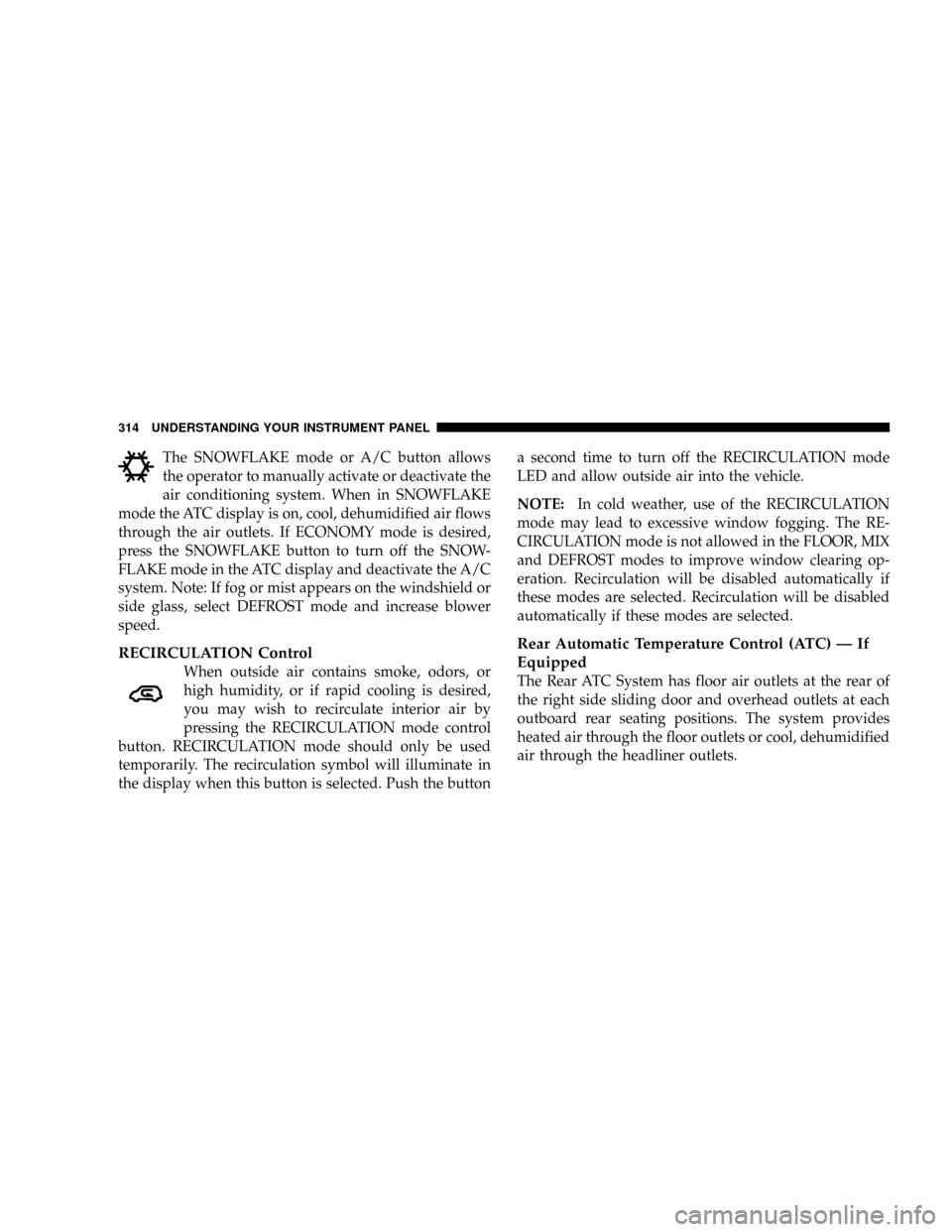
The SNOWFLAKE mode or A/C button allows
the operator to manually activate or deactivate the
air conditioning system. When in SNOWFLAKE
mode the ATC display is on, cool, dehumidified air flows
through the air outlets. If ECONOMY mode is desired,
press the SNOWFLAKE button to turn off the SNOW-
FLAKE mode in the ATC display and deactivate the A/C
system. Note: If fog or mist appears on the windshield or
side glass, select DEFROST mode and increase blower
speed.
RECIRCULATION Control
When outside air contains smoke, odors, or
high humidity, or if rapid cooling is desired,
you may wish to recirculate interior air by
pressing the RECIRCULATION mode control
button. RECIRCULATION mode should only be used
temporarily. The recirculation symbol will illuminate in
the display when this button is selected. Push the buttona second time to turn off the RECIRCULATION mode
LED and allow outside air into the vehicle.
NOTE:In cold weather, use of the RECIRCULATION
mode may lead to excessive window fogging. The RE-
CIRCULATION mode is not allowed in the FLOOR, MIX
and DEFROST modes to improve window clearing op-
eration. Recirculation will be disabled automatically if
these modes are selected. Recirculation will be disabled
automatically if these modes are selected.
Rear Automatic Temperature Control (ATC) Ð If
Equipped
The Rear ATC System has floor air outlets at the rear of
the right side sliding door and overhead outlets at each
outboard rear seating positions. The system provides
heated air through the floor outlets or cool, dehumidified
air through the headliner outlets.
314 UNDERSTANDING YOUR INSTRUMENT PANEL
Page 320 of 531
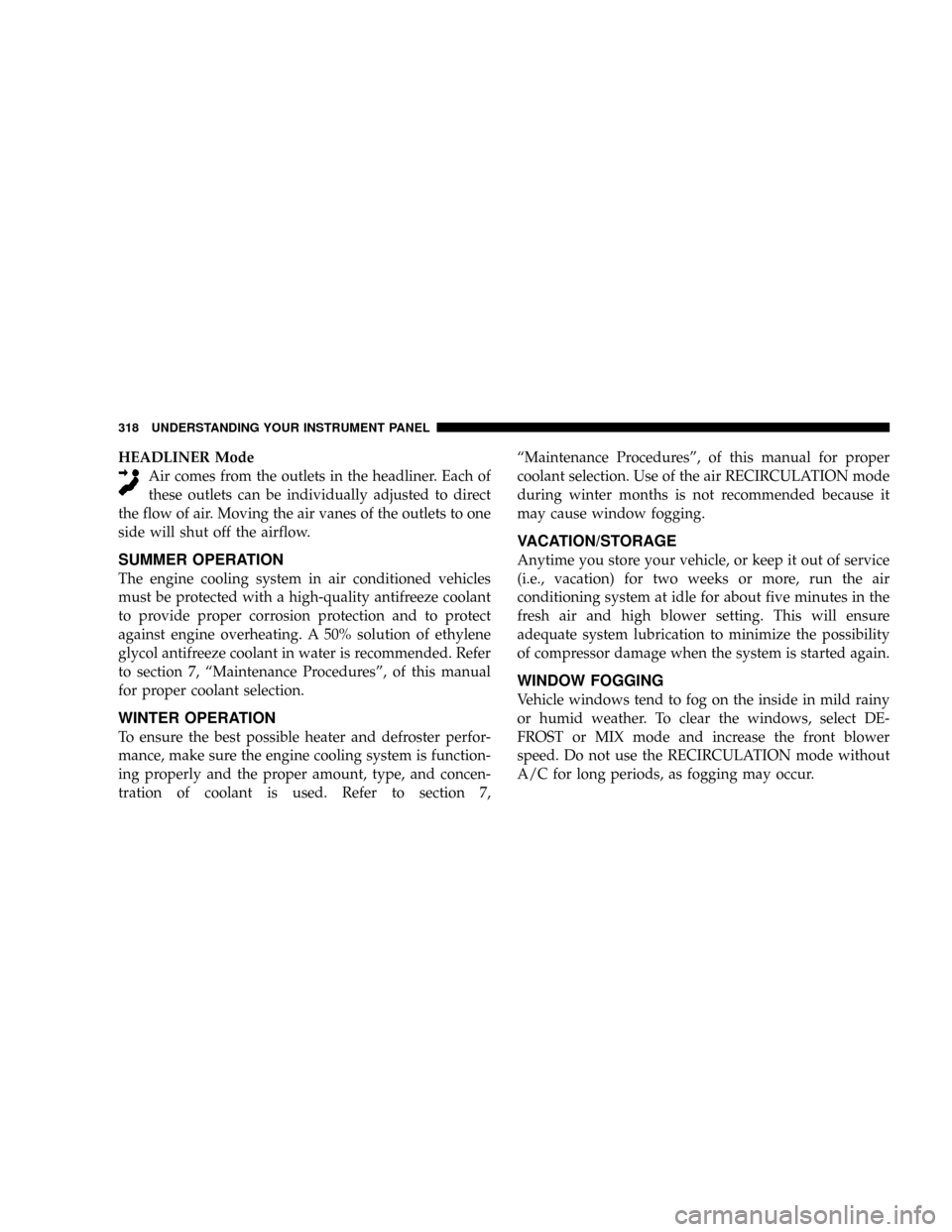
HEADLINER Mode
Air comes from the outlets in the headliner. Each of
these outlets can be individually adjusted to direct
the flow of air. Moving the air vanes of the outlets to one
side will shut off the airflow.
SUMMER OPERATION
The engine cooling system in air conditioned vehicles
must be protected with a high-quality antifreeze coolant
to provide proper corrosion protection and to protect
against engine overheating. A 50% solution of ethylene
glycol antifreeze coolant in water is recommended. Refer
to section 7, ªMaintenance Proceduresº, of this manual
for proper coolant selection.
WINTER OPERATION
To ensure the best possible heater and defroster perfor-
mance, make sure the engine cooling system is function-
ing properly and the proper amount, type, and concen-
tration of coolant is used. Refer to section 7,ªMaintenance Proceduresº, of this manual for proper
coolant selection. Use of the air RECIRCULATION mode
during winter months is not recommended because it
may cause window fogging.
VACATION/STORAGE
Anytime you store your vehicle, or keep it out of service
(i.e., vacation) for two weeks or more, run the air
conditioning system at idle for about five minutes in the
fresh air and high blower setting. This will ensure
adequate system lubrication to minimize the possibility
of compressor damage when the system is started again.
WINDOW FOGGING
Vehicle windows tend to fog on the inside in mild rainy
or humid weather. To clear the windows, select DE-
FROST or MIX mode and increase the front blower
speed. Do not use the RECIRCULATION mode without
A/C for long periods, as fogging may occur.
318 UNDERSTANDING YOUR INSTRUMENT PANEL
Page 322 of 531
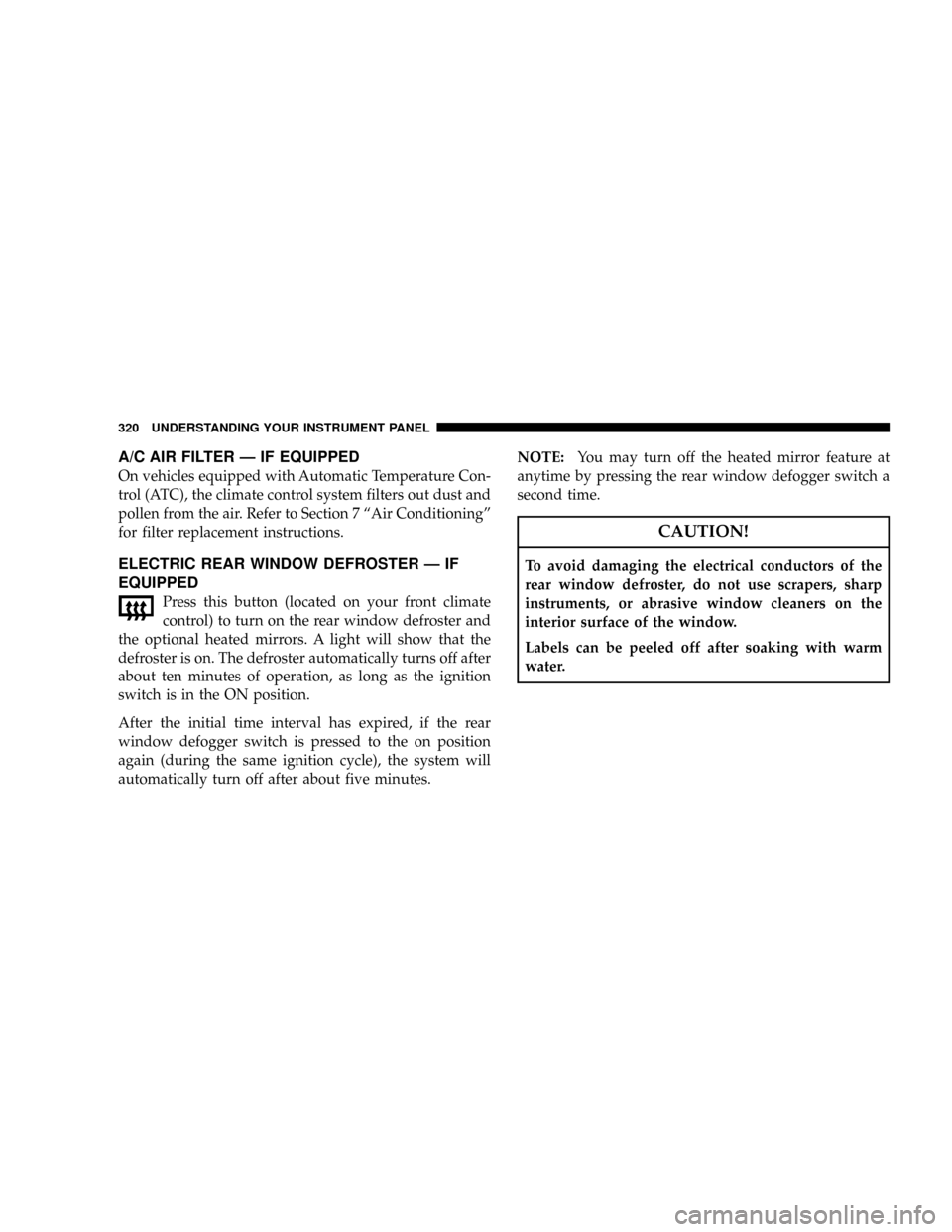
A/C AIR FILTER Ð IF EQUIPPED
On vehicles equipped with Automatic Temperature Con-
trol (ATC), the climate control system filters out dust and
pollen from the air. Refer to Section 7 ªAir Conditioningº
for filter replacement instructions.
ELECTRIC REAR WINDOW DEFROSTER Ð IF
EQUIPPED
Press this button (located on your front climate
control) to turn on the rear window defroster and
the optional heated mirrors. A light will show that the
defroster is on. The defroster automatically turns off after
about ten minutes of operation, as long as the ignition
switch is in the ON position.
After the initial time interval has expired, if the rear
window defogger switch is pressed to the on position
again (during the same ignition cycle), the system will
automatically turn off after about five minutes.NOTE:You may turn off the heated mirror feature at
anytime by pressing the rear window defogger switch a
second time.
CAUTION!
To avoid damaging the electrical conductors of the
rear window defroster, do not use scrapers, sharp
instruments, or abrasive window cleaners on the
interior surface of the window.
Labels can be peeled off after soaking with warm
water.
320 UNDERSTANDING YOUR INSTRUMENT PANEL
Page 362 of 531
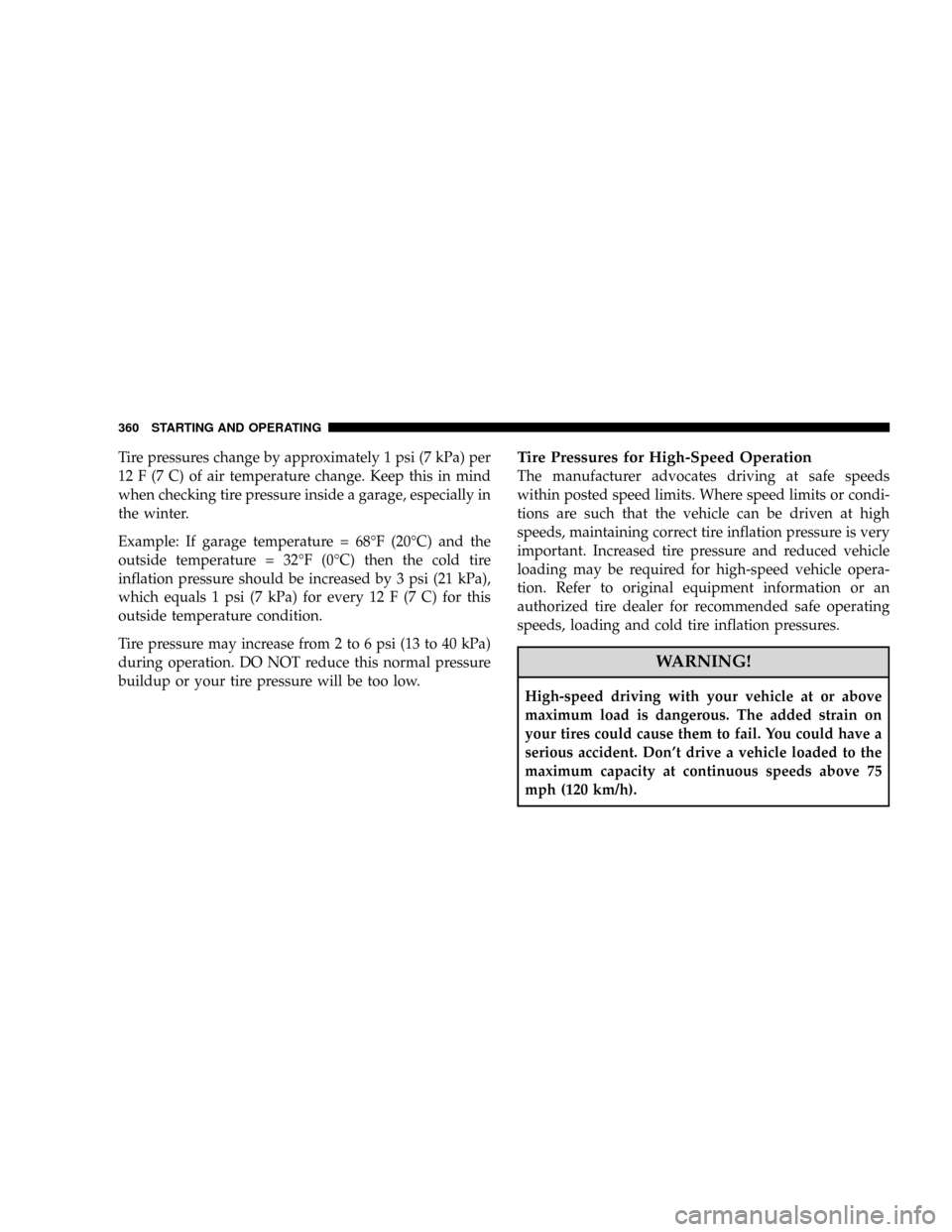
Tire pressures change by approximately 1 psi (7 kPa) per
12 F (7 C) of air temperature change. Keep this in mind
when checking tire pressure inside a garage, especially in
the winter.
Example: If garage temperature = 68ÉF (20ÉC) and the
outside temperature = 32ÉF (0ÉC) then the cold tire
inflation pressure should be increased by 3 psi (21 kPa),
which equals 1 psi (7 kPa) for every 12 F (7 C) for this
outside temperature condition.
Tire pressure may increase from 2 to 6 psi (13 to 40 kPa)
during operation. DO NOT reduce this normal pressure
buildup or your tire pressure will be too low.Tire Pressures for High-Speed Operation
The manufacturer advocates driving at safe speeds
within posted speed limits. Where speed limits or condi-
tions are such that the vehicle can be driven at high
speeds, maintaining correct tire inflation pressure is very
important. Increased tire pressure and reduced vehicle
loading may be required for high-speed vehicle opera-
tion. Refer to original equipment information or an
authorized tire dealer for recommended safe operating
speeds, loading and cold tire inflation pressures.
WARNING!
High-speed driving with your vehicle at or above
maximum load is dangerous. The added strain on
your tires could cause them to fail. You could have a
serious accident. Don't drive a vehicle loaded to the
maximum capacity at continuous speeds above 75
mph (120 km/h).
360 STARTING AND OPERATING
Page 365 of 531
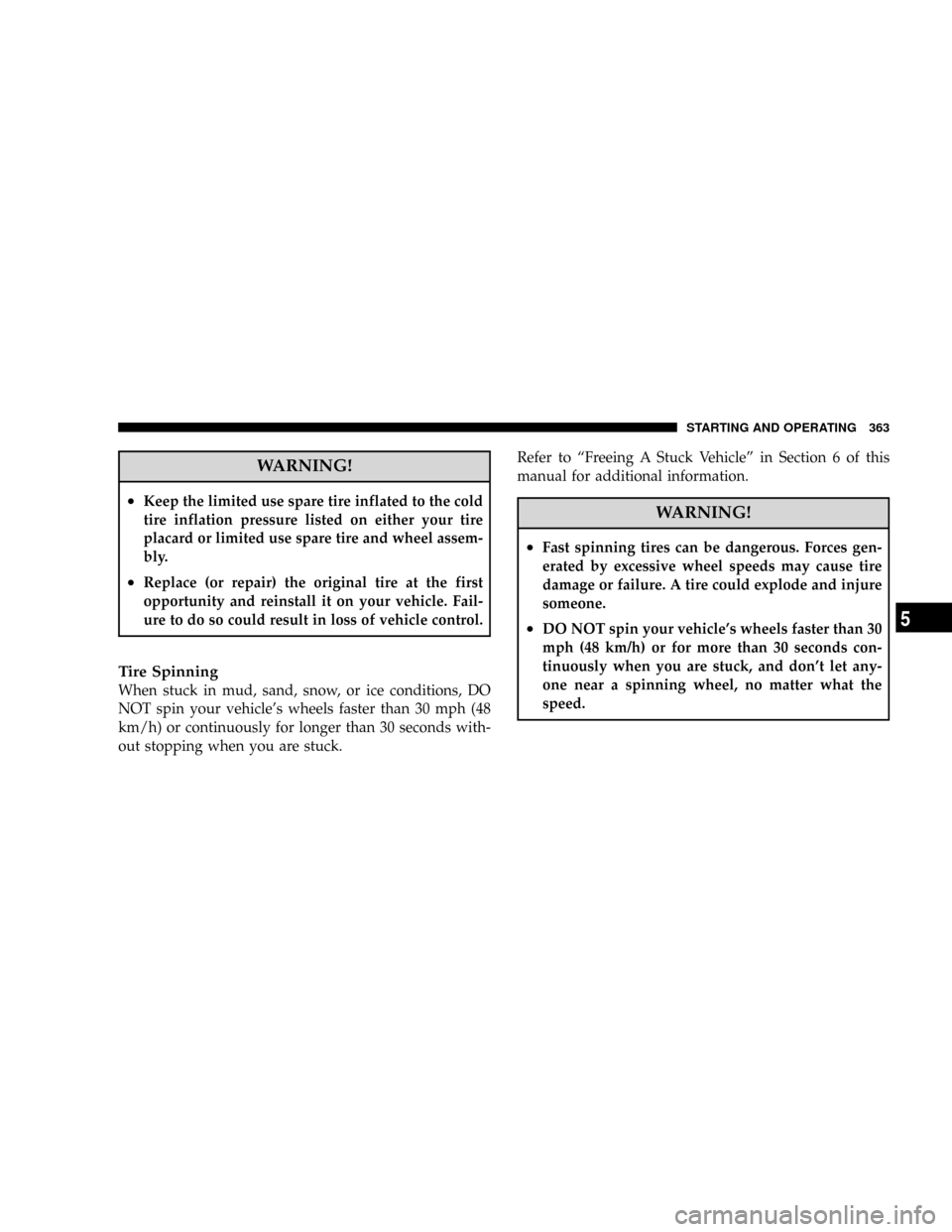
WARNING!
²Keep the limited use spare tire inflated to the cold
tire inflation pressure listed on either your tire
placard or limited use spare tire and wheel assem-
bly.
²Replace (or repair) the original tire at the first
opportunity and reinstall it on your vehicle. Fail-
ure to do so could result in loss of vehicle control.
Tire Spinning
When stuck in mud, sand, snow, or ice conditions, DO
NOT spin your vehicle's wheels faster than 30 mph (48
km/h) or continuously for longer than 30 seconds with-
out stopping when you are stuck.Refer to ªFreeing A Stuck Vehicleº in Section 6 of this
manual for additional information.
WARNING!
²Fast spinning tires can be dangerous. Forces gen-
erated by excessive wheel speeds may cause tire
damage or failure. A tire could explode and injure
someone.
²DO NOT spin your vehicle's wheels faster than 30
mph (48 km/h) or for more than 30 seconds con-
tinuously when you are stuck, and don't let any-
one near a spinning wheel, no matter what the
speed.
STARTING AND OPERATING 363
5
Page 371 of 531
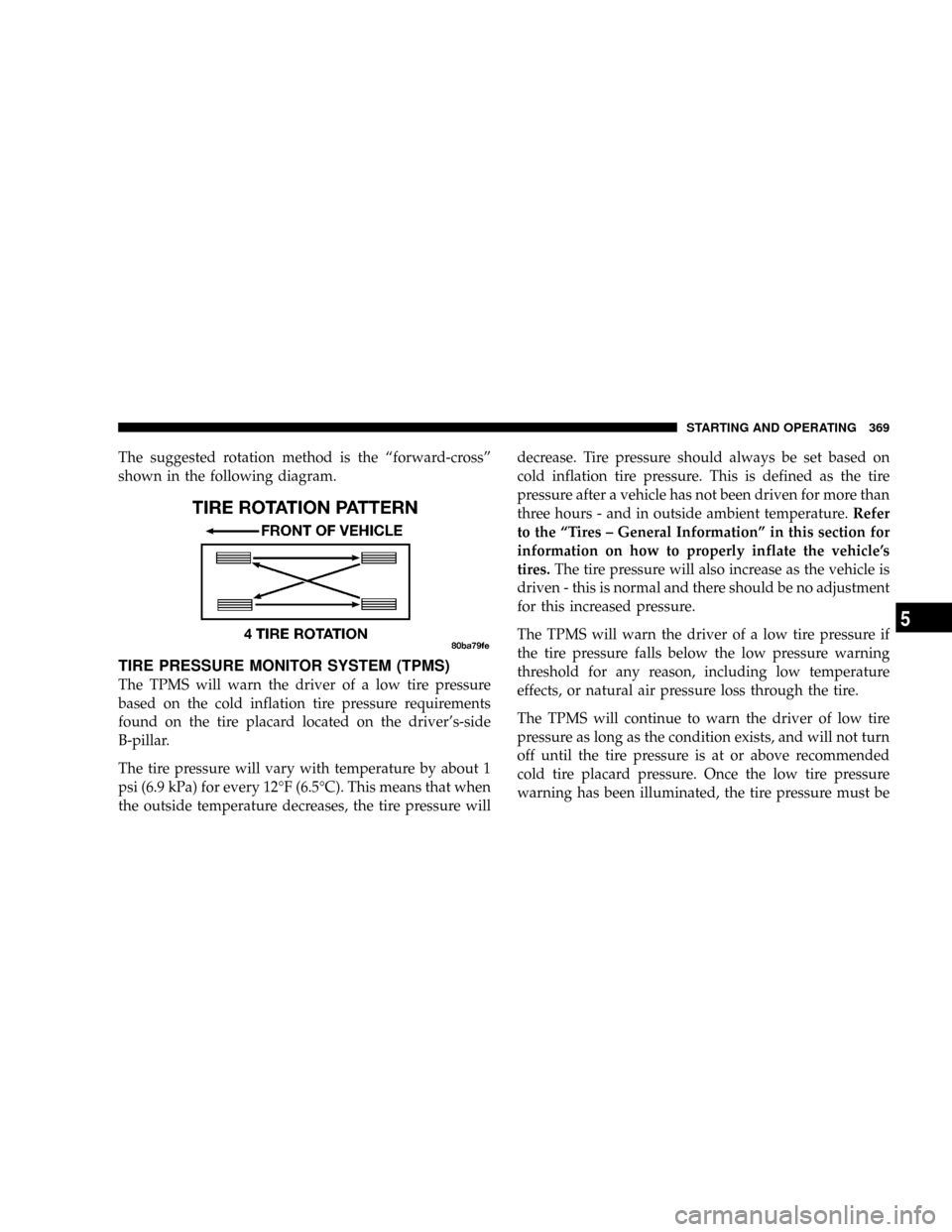
The suggested rotation method is the ªforward-crossº
shown in the following diagram.
TIRE PRESSURE MONITOR SYSTEM (TPMS)
The TPMS will warn the driver of a low tire pressure
based on the cold inflation tire pressure requirements
found on the tire placard located on the driver's-side
B-pillar.
The tire pressure will vary with temperature by about 1
psi (6.9 kPa) for every 12ÉF (6.5ÉC). This means that when
the outside temperature decreases, the tire pressure willdecrease. Tire pressure should always be set based on
cold inflation tire pressure. This is defined as the tire
pressure after a vehicle has not been driven for more than
three hours - and in outside ambient temperature.Refer
to the ªTires ± General Informationº in this section for
information on how to properly inflate the vehicle's
tires.The tire pressure will also increase as the vehicle is
driven - this is normal and there should be no adjustment
for this increased pressure.
The TPMS will warn the driver of a low tire pressure if
the tire pressure falls below the low pressure warning
threshold for any reason, including low temperature
effects, or natural air pressure loss through the tire.
The TPMS will continue to warn the driver of low tire
pressure as long as the condition exists, and will not turn
off until the tire pressure is at or above recommended
cold tire placard pressure. Once the low tire pressure
warning has been illuminated, the tire pressure must be
STARTING AND OPERATING 369
5